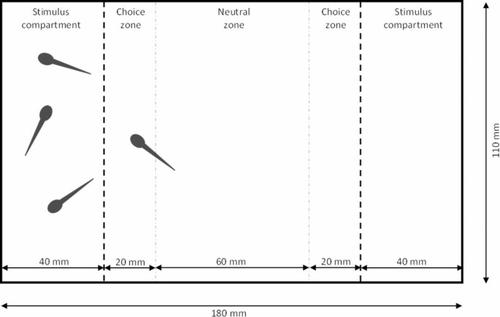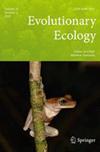Four’s a crowd: social preferences for larger groups in golden mantella (Mantella aurantiaca) tadpoles
IF 2.1
3区 环境科学与生态学
Q3 ECOLOGY
引用次数: 0
Abstract
Abstract Group living results in various benefits and costs, which often depend on group size and ontogenetic state of the individual. Therefore, certain group sizes are favourable over others, often depending on individual age or intrinsic state. Under natural conditions many amphibians can be found in aggregations, especially during the larval stage. Yet, whether these aggregations are the result of active social preferences or are driven by environmental factors has only been tested in a limited number of taxa. This study explores social preferences and group size discrimination in golden mantella ( Mantella aurantiaca ) tadpoles. We gave tadpoles the choice between different numbers of conspecifics using a two-choice design. To test for general social tendency, tadpoles could either join a group of three or remain solitary (3 vs. 0). To test for group size preferences, we tested tadpoles in two different ratios: 2 vs. 1 and 4 vs. 2 conspecifics. We repeated the trials weekly until metamorphosis to determine potential shifts in preference through ontogeny. Tadpoles preferred being with a group over being alone, and the strength of this preference declined with increasing age. Furthermore, tadpoles preferred to be close to the larger of two groups. This preference was stronger in the 2 vs. 1 treatment. Mantella aurantiaca tadpoles, therefore, show clear social tendencies and possess the ability to spontaneously discriminate between group sizes. The lower preference at higher group sizes might indicate cognitive limitations or lower benefits of choosing the larger of two groups when overall group size is high. These findings are one of the few showing social preferences depending on group size in tadpoles and contribute to our understanding of social behaviour in amphibians in general.

四是一个群体:金蝠鲼(mantella aurantiaca)蝌蚪对大群体的社会偏好
群体生活产生各种效益和成本,往往取决于群体规模和个体的个体发育状态。因此,某些群体的规模比其他群体更有利,这通常取决于个人的年龄或内在状态。在自然条件下,可以发现许多两栖动物聚集在一起,特别是在幼虫阶段。然而,这些聚集是积极的社会偏好的结果,还是由环境因素驱动的结果,只在有限数量的分类群中进行了测试。本研究探讨了金蝠鲼蝌蚪的社会偏好和群体大小歧视。我们使用双选择设计,让蝌蚪在不同数量的同种昆虫之间做出选择。为了测试一般的社会倾向,蝌蚪可以加入一个3对0的群体或保持孤独(3对0)。为了测试群体大小偏好,我们以两种不同的比例测试了蝌蚪:2对1和4对2。我们每周重复试验直到变态,以确定通过个体发生的潜在偏好变化。蝌蚪喜欢和一群人在一起,而不是独自一人,这种偏好的强度随着年龄的增长而下降。此外,蝌蚪更喜欢靠近两组中较大的一组。这种偏好在2比1治疗中更强。因此,Mantella aurantiaca蝌蚪表现出明显的社会倾向,并具有自发区分群体大小的能力。在群体规模较大的情况下,偏好较低可能表明认知限制,或者在群体规模较大的情况下,在两个群体中选择较大的群体收益较低。这些发现是少数显示蝌蚪群体大小对社会偏好的研究之一,有助于我们对两栖动物社会行为的总体理解。
本文章由计算机程序翻译,如有差异,请以英文原文为准。
求助全文
约1分钟内获得全文
求助全文
来源期刊

Evolutionary Ecology
环境科学-进化生物学
CiteScore
3.00
自引率
5.30%
发文量
70
审稿时长
3 months
期刊介绍:
Evolutionary Ecology is a concept-oriented journal of biological research at the interface of ecology and evolution. We publish papers that therefore integrate both fields of research: research that seeks to explain the ecology of organisms in the context of evolution, or patterns of evolution as explained by ecological processes.
The journal publishes original research and discussion concerning the evolutionary ecology of organisms. These may include papers addressing evolutionary aspects of population ecology, organismal interactions and coevolution, behaviour, life histories, communication, morphology, host-parasite interactions and disease ecology, as well as ecological aspects of genetic processes. The objective is to promote the conceptual, theoretical and empirical development of ecology and evolutionary biology; the scope extends to any organism or system.
In additional to Original Research articles, we publish Review articles that survey recent developments in the field of evolutionary ecology; Ideas & Perspectives articles which present new points of view and novel hypotheses; and Comments on articles recently published in Evolutionary Ecology or elsewhere. We also welcome New Tests of Existing Ideas - testing well-established hypotheses but with broader data or more methodologically rigorous approaches; - and shorter Natural History Notes, which aim to present new observations of organismal biology in the wild that may provide inspiration for future research. As of 2018, we now also invite Methods papers, to present or review new theoretical, practical or analytical methods used in evolutionary ecology.
Students & Early Career Researchers: We particularly encourage, and offer incentives for, submission of Reviews, Ideas & Perspectives, and Methods papers by students and early-career researchers (defined as being within one year of award of a PhD degree) – see Students & Early Career Researchers
 求助内容:
求助内容: 应助结果提醒方式:
应助结果提醒方式:


